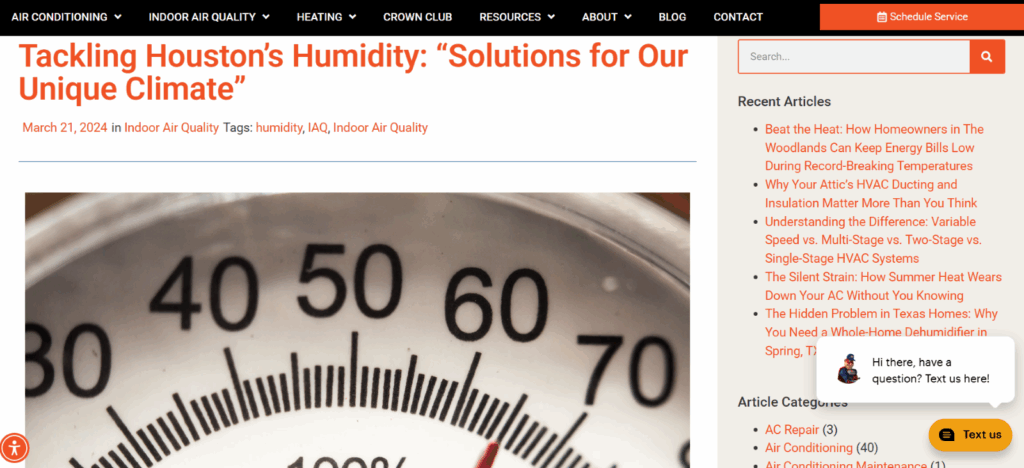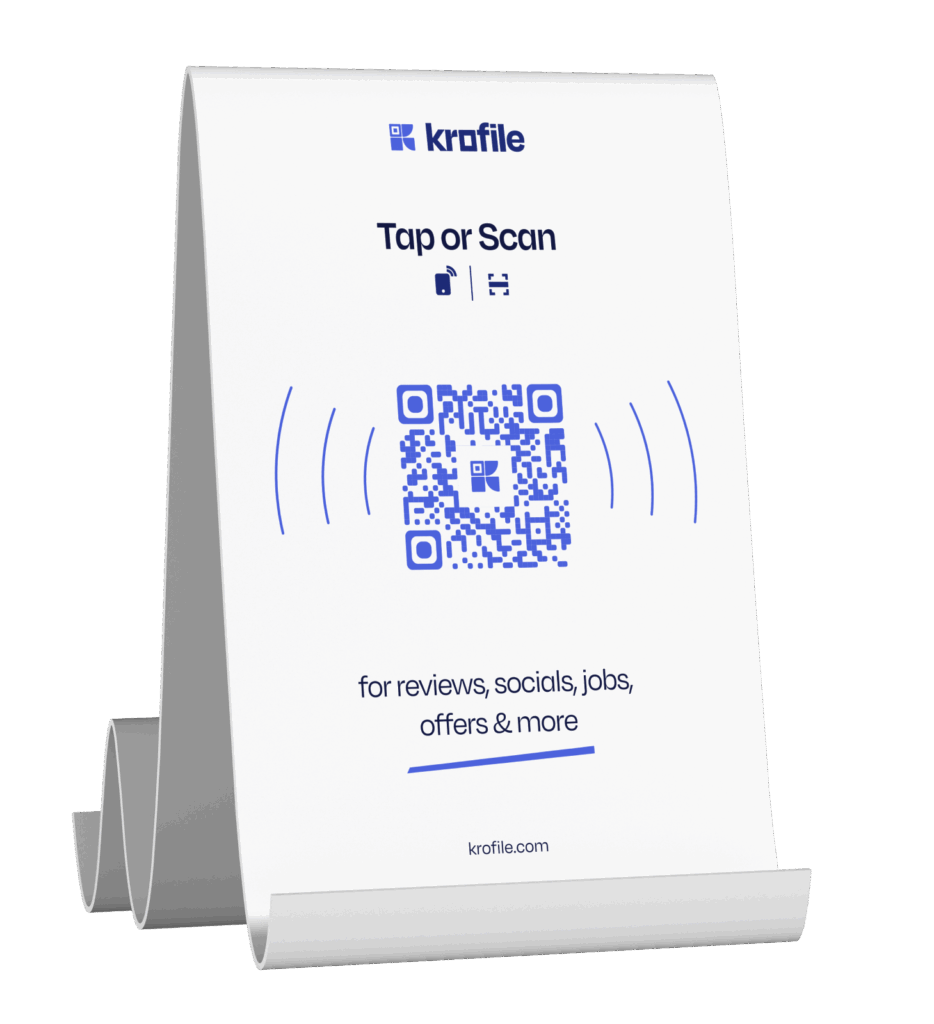Most HVAC businesses struggle because they don’t use the right hvac marketing strategies.
Here’s what I discovered while helping several HVAC businesses grow: homeowners call the first contractor they find online, not the best one in town.
Think about it: 1.5 billion “near me” searches happen every month. When someone’s air conditioner breaks on a hot summer day, they don’t ask neighbors for recommendations. They grab their phone and search “HVAC repair near me.”
Here’s the problem: if you’re not showing up in those searches, you’re losing customers to competitors who might not even be better than you.
The good news? I’ve seen hvac companies completely turn this around using simple marketing tactics. Local businesses in the heating and cooling industry can attract more customers when they know what works.
Let me show you 13 proven ways to get more customers for your HVAC business.
13 Best HVAC Marketing Strategies for 2025
Here are some of the best marketing strategies for HVAC companies that have consistently given the best results to my clients.
1) Improve Your HVAC Website SEO
Your website is where customers decide if they trust you enough to call. Most hvac companies lose potential customers because their websites don’t show up when people search or look unprofessional when they do.
Make Your Website Mobile-Friendly
Here’s something that shocked me: 58% of people search for local businesses on their phones, but most HVAC websites look terrible on mobile devices.
Think about it: when someone’s air conditioner breaks on a Saturday afternoon, they’re not going to their computer. They grab their phone and search “AC repair near me.” If your website takes forever to load or they can’t easily find your phone numbers, they’ll call your competitor instead.
I always tell my clients to test their own websites on their phones. Can you easily read the text without zooming in? Are your contact information and service buttons easy to tap? Can visitors request a quote without getting frustrated?

For example, look at this website on mobile and see how easy it is for customers to find everything, phone numbers, requesting a service, etc.
Create Location-Specific Pages
This simple strategy has helped my clients outrank competitors who’ve been in business for decades. Instead of having one generic page that says “We serve the greater metro area,” create separate pages for each city you work in.
Here’s what I mean:
- “Air Conditioning Repair in Richardson, TX”
- “Furnace Installation in Plano, TX”
- “HVAC Maintenance in McKinney, TX”

On each page, mention local landmarks, neighborhoods, and specific areas you serve. Talk about local climate challenges that affect HVAC systems in that area.
Why This Works So Well
When someone in Richardson searches “AC repair Richardson,” Google wants to show them businesses that actually serve Richardson. If your website has a dedicated page for Richardson with local information, you’re much more likely to show up first.
The local businesses that dominate search results all do this. They don’t try to rank for everything everywhere. They focus on the specific areas they serve and create detailed pages for each location.
Essential SEO Elements for Your Pages
Every page on your website should include:
- Your business name and contact information in the footer
- Clear phone numbers that are easy to call on mobile
- Service areas and cities you cover
- Customer reviews and testimonials
- Photos of your actual team and completed work
Remember: Google rewards websites that help people find what they’re looking for quickly and easily.
2) Optimize Google Business Profile for More Leads
Your Google My Business profile is the first thing customers see when they search for hvac companies near them. Get this wrong, and you’ll lose customers before they even call.
Complete Every Single Section
Most hvac businesses fill out the basics and stop there. That’s a huge mistake. Complete profiles get 70% more calls than incomplete ones.
Add your services, business hours, service areas, and multiple phone numbers. Upload photos of your team, your work trucks, and recent jobs. Show people the real faces behind your business.

For example: This HVAC maintenance company provides all the details on Google Business Profile including their service areas.
Post Regular Updates
Here’s what successful local businesses do: they treat their Google profile like social media. Post seasonal maintenance tips, special offers, or photos from recent jobs.
When you stay active, Google shows your profile to more people.
Respond to All Reviews
Every customer review deserves a response. Thank people for positive reviews and professionally address concerns in negative ones. This shows potential customers you care about service quality.
Use the Messaging Feature
Turn on messaging so customers can ask questions directly through your profile. Quick responses can turn searchers into paying customers.
Also read: How to optimize your business for near me searches
3) Get Listed on Business Directories
Getting your hvac company listed on business directories helps you show up in more places when customers search for heating and cooling services.
Why Directories Still Matter
While most people start their search on Google, many also check sites like Yelp, Angi, and the Better Business Bureau before choosing an HVAC contractor. When your business appears on multiple trusted directories, it signals to Google that you’re a legitimate local business.
Focus on Quality, Not Quantity
Don’t waste time submitting to every directory you find. Focus on the ones your customers actually use:
- Yelp (most people check this for reviews)
- Better Business Bureau (builds trust and credibility)
- Angi (formerly Angie’s List)
- Home Advisor
- Local Chamber of Commerce directory

Keep Your Information Consistent
Here’s something critical: your business name, address, and phone numbers must be exactly the same on every directory. Even small differences can confuse Google and hurt your local seo rankings.
Claim and Complete Your Profiles
Don’t just submit basic information. Add photos, detailed service descriptions, and your service areas. The more complete your profiles, the more likely customers are to choose you over competitors.
Read more: Check out our list of free local business directories
4) Create Educational Content to Increase Reach and Trust
Now let’s talk about the main ingredient which can get you in front of new customers and also establish your authority.
I have seen most hvac companies only talk about their services, but the businesses that get the most customers also teach people about heating and cooling. When you educate potential customers, they start trusting you before they even call.
Why Educational Content Works
Think about it: when your air conditioner stops working, you probably search “why is my AC not cooling” before you search for a repair company. If your business shows up with a helpful video explaining the problem, you’re already ahead of competitors who only have basic service pages.
Create Location-Specific Content
Don’t just make generic content. Make it specific to your area:
- “Why Houston AC Units Struggle in High Humidity”
- “Fall HVAC Maintenance Tips for Dallas Homeowners”
- “Common Furnace Problems in Chicago Winters”

For instance, see how this brand solved this customer problem into a business opportunity.
This helps you rank for local seo searches while showing you understand local climate challenges.
Use Different Content Formats
People consume content differently, so mix it up:
- Short videos showing simple maintenance tips
- Instagram Reels explaining common HVAC problems
- TikTok videos answering customer questions
- Before-and-after photos of your work

Content Ideas That Actually Help People
Here are topics that website visitors actually search for:
- How to change HVAC filters
- Why energy bills are suddenly high
- Strange noises coming from heating systems
- When to call for emergency service
The goal isn’t to go viral. It’s to show potential customers that you know what you’re talking about and genuinely care about helping them solve problems.
5) Encourage HVAC Clients for Google Reviews
Customer reviews are the most powerful tool for getting new customers. When people search for hvac companies, they look at reviews before they look at anything else.
Here’s the problem: most happy customers won’t leave reviews unless you ask them. Even if you did amazing work and they’re thrilled with your service, they’re busy and simply forget.
Ask at the Perfect Time
The best time to ask for a review is right after you finish a job and the customer is happy. Don’t wait a week or send an email later. Ask while you’re still there and the positive experience is fresh in their mind.
Make It Super Easy with Technology
Don’t just say “Please leave us a review on Google.” Show them exactly how to do it. This is where Krofile becomes a game-changer for hvac businesses.
With Krofile, you can create dynamic QR codes that take customers directly to your review pages. Instead of customers having to search for your business online, they simply scan the code and instantly land on your Google My Business review section.

Use These Review-Getting Strategies
Here are tactics that actually work for local businesses:
- Create a Krofile QR code and add it to your business cards
- Show the QR code on your phone after completing work
- Include the code on invoices and service receipts
- Send a text message with a direct link to your review page
- Follow up with a friendly email the day after completing work
Why Krofile Makes This Easier
Traditional QR codes are static, but Krofile’s dynamic codes let you update where they lead without reprinting anything. You can track how many people scan your codes and even A/B test different review requests.
Respond to Every Review
When someone takes time to write a review, always respond. Thank them for positive reviews and professionally address any concerns in negative ones. This shows potential customers that you care about feedback and customer service.
Also read: Learn proven review generation strategies
6) Run High Converting Email Campaigns
Email marketing delivers $42 for every $1 spent, making it one of the highest-converting channels for local businesses. Yet most hvac companies collect email addresses but never use them effectively.
Build Your Email List Strategically
Collect emails every chance you get:
- When you give estimates
- After completing service calls
- Through your website contact forms
- During seasonal maintenance visits
Send Seasonal Campaigns That Convert
HVAC is a seasonal business, so time your emails perfectly:
- Spring: AC tune-up reminders before summer heat
- Summer: Energy-saving tips and emergency service info
- Fall: Heating system check reminders
- Winter: Maintenance tips and special offers
Focus on Value, Not Just Sales
Send maintenance reminders, helpful tips, and seasonal advice. When people find your emails useful, they’re 73% more likely to call you when they need services.
Track What Works
Monitor which emails get opened and which ones generate actual service calls. Double down on the campaigns that bring in customers and adjust the ones that don’t perform.
Email keeps you top-of-mind when customers need HVAC services most.
7) Build Strong Customer Relations
HVAC work is different from other trades because customers are letting you into their homes to work on expensive equipment that keeps their families comfortable. Trust isn’t just nice to have – it’s everything.
Why Customer Relations Matter for HVAC
HVAC technicians are specialized professionals with certifications that go beyond basic electrical work. When someone’s $5,000 air conditioning system breaks down, they’re not looking for the cheapest option. They want someone trustworthy and experienced who won’t make the problem worse.
Provide Outstanding Customer Experience
Here’s what great customer service looks like for hvac companies:
- Show up exactly when you say you will
- Call if you’re running even 10 minutes late
- Explain problems in simple terms, not technical jargon
- Clean up completely after finishing work
- Follow up to make sure everything is working properly
Communicate Like a Professional
Most customers don’t understand HVAC systems. Instead of saying “Your evaporator coil is frozen,” explain it simply: “Part of your AC system has ice on it, which stops it from cooling your house. Here’s what we need to do to fix it.”
Build Long-Term Relationships
Don’t just fix the immediate problem and leave. Help customers understand basic maintenance and when to call for service. When they see you as their trusted HVAC expert, they call you first when problems happen.
The Power of Loyal Customers
Happy customers become your best marketing tool. They refer neighbors, leave positive customer reviews, and call you for all their future HVAC needs. Word-of-mouth referrals convert at much higher rates than any paid advertising.
Also read: Learn more about building customer loyalty
8) Implement Paid Ads
Paid advertising can bring you customers fast, but most hvac companies waste money because they advertise to everyone instead of targeting the right people at the right time.
Use Geofencing for Hyper-Local Targeting
Geofencing lets you show ads only to people in specific areas. Instead of advertising to your entire city, you can target people within 10 miles of your location or in neighborhoods where you want more customers.
Here’s why this works: when someone’s AC breaks and they search “emergency AC repair,” you want your ad showing to people you can actually help quickly, not someone 50 miles away.

Target People When They Need You Most
HVAC emergencies happen at predictable times:
- Hot summer afternoons when AC units overwork
- Cold winter mornings when heaters fail overnight
- Monday mornings when people discover weekend problems
Increase your ad spending during these peak times and reduce it when demand is low.
Create Ads That Solve Problems
Your ads should speak directly to people’s urgent needs:
- “AC Broke? Same-Day Repair Available”
- “Emergency Furnace Repair – Available 24/7”
- “Free Estimates on New AC Installation”
Track Your Investment
Know exactly which ads bring in paying customers. Use different phone numbers for different ads so you can see which campaigns generate actual jobs, not just clicks.
The key is starting small, testing what works, and scaling up the ads that bring you profitable customers.
9) Set up Customer Referral Programs
Happy customers are your best source of new business, but most won’t refer people unless you give them a good reason to do it.
Make Referrals Worth Their Time
Offer something valuable that motivates customers to actually refer people:
- $75 credit for each new customer they send you
- Free annual maintenance visit for successful referrals
- Gift cards to popular local restaurants
- Cash bonuses for multiple referrals
Ask at the Perfect Moment
The best time to ask for referrals is right after you solve a customer’s problem. They’re grateful, your work is fresh in their mind, and they want to help friends avoid the stress they just experienced.
Make It Simple to Refer
Give customers tools that make referring easy:
- Refrigerator magnets with your contact information
- Simple referral forms on your website
Follow Up on Every Referral
When someone refers a customer to you, always thank them and let them know how it went. This encourages them to refer more people and shows you value their help.
Track Your Referral Success
Know which customers send you the most referrals and take extra care of them. These customer reviews and word-of-mouth recommendations convert better than any paid advertising.
A good referral program turns every satisfied customer into a member of your sales team.
10) Utilize Business Cards
Business cards might seem old-fashioned, but they’re still one of the most effective ways for local businesses to share contact information quickly and professionally.
Why Digital Business Cards Beat Paper
Traditional paper cards get lost, thrown away, or damaged. Digital business cards stay on people’s phones forever and can include much more than just your phone numbers.
Create Powerful Digital Cards with Krofile
With Krofile, you can create a comprehensive digital business card that includes:
- All your contact information and service areas
- Direct links to your customer reviews
- Photos of your recent HVAC work
- Service descriptions and pricing information
- Easy quote request buttons
How to Share Your Digital Card
Instead of handing out paper cards, you can share your Krofile card through:
- QR codes people scan with their phones
- Text messages with a direct link
- Email signatures
- Social media profiles
When customers save your digital card, they always have your information when their HVAC system needs attention. Plus, you can update your information anytime without reprinting anything.
11) Turn Your Work Trucks into Moving Billboards
Vehicle wraps are a cool hvac marketing idea that you can do without burning much cash, and they work 24/7 to advertise your business everywhere you drive. There are several HVAC marketing examples but among them, this is one of my favorites.

Design for Maximum Impact
Your vehicle wrap should grab attention and be easy to read from a distance:
- Your business name in large, bold letters
- Phone numbers that people can actually read while driving
- Clear list of services you provide
- Your website and service areas
- QR code linking for instant access
Strategic Parking Gets Results
Think about where you park your trucks. Parking at busy shopping centers, home improvement stores, or in neighborhoods where you’re working generates extra visibility and potential customers.
Keep It Professional
A clean, well-maintained truck with a professional wrap reflects the quality of your work. A dirty vehicle with peeling graphics sends the wrong message to potential customers.
Track Your Results
Ask new customers how they heard about you. You’ll be surprised how many people call because they saw your truck around town. Vehicle wraps often pay for themselves within the first few months.
12) Partner with Local Businesses
Building relationships with other local businesses can become one of your best sources of steady referrals without spending money on advertising.
Find the Right Partners
Look for businesses that serve similar customers but don’t compete with you:
- Real estate agents who work with home buyers and sellers
- General contractors who need reliable HVAC subcontractors
- Home inspectors who find HVAC problems during inspections
- Appliance stores that sell heating and cooling equipment
- Property managers who oversee rental properties
Create Win-Win Relationships
Don’t just ask for referrals. Find ways to help other businesses too. You might refer customers to a trusted electrician or plumber in exchange for them sending HVAC customers your way.
Get Active in Your Community
Join your local Chamber of Commerce, attend networking events, and participate in community activities. The more people know you and trust your business, the more likely they are to refer customers.
Follow Up on Partnerships
When someone refers a customer to you, always thank them and let them know how it went. This keeps the referral relationship strong and encourages them to send more business your way.
Good partnerships can provide steady referrals for years while helping you build a strong reputation in your community.
13) Use HVAC Marketing Tools to Measure Results
Finally, use marketing tools to measure results. You can’t improve what you don’t measure, and the most successful hvac companies track everything to see what’s actually bringing in customers.
Here Are the Best 5 Marketing Tools:
1. Google Analytics:
Track your website visitors, where they come from, and which pages they visit most. This free tool shows you which marketing ideas are driving the most traffic to your site.
2. Call Tracking Software:
Use different phone numbers for different marketing channels. This tells you exactly which ads, directories, or campaigns are generating actual phone calls from potential customers.
3. Customer Relationship Management (CRM):
Tools like HubSpot help you track leads from first contact to completed jobs. You’ll know which lead generation sources bring in customers who actually hire you.
4. Review Management Platforms:
Monitor your online reviews across Google, Yelp, and other directories. These tools alert you to new reviews and help you respond quickly to maintain your reputation.
5. Social Media Analytics:
Track engagement on your educational content, see which posts generate the most calls, and understand what your audience wants to learn about HVAC systems.
Calculate Your Return on Investment
For every marketing plan strategy you use, calculate how much it costs versus how much revenue it brings in. Focus your time and money on the tactics that give you the best results.
Common HVAC Marketing Mistakes to Avoid
I’ve seen hvac companies make the same expensive mistakes over and over. Here are the biggest ones that waste money and lose customers:
Ignoring Mobile Users
Most hvac businesses have websites that look terrible on phones, but 58% of people search for local businesses on mobile devices. If your site doesn’t work on phones, you’re losing customers before they even call.
Incomplete Google Business Profile
Many hvac companies set up their Google My Business profile once and forget about it. Incomplete profiles with old phone numbers, missing photos, and no customer reviews responses lose customers to competitors.
Generic Marketing Messages
Saying “we fix air conditioners” doesn’t help you stand out. Local businesses that succeed focus on specific problems: “Emergency AC repair in under 2 hours” or “No overtime charges on weekends.”
Not Tracking Results
Most hvac marketing strategies fail because business owners don’t measure what works. Without tracking which ads bring in customers, you waste money on hvac advertising that doesn’t generate lead generation.
Neglecting Email Follow-Up
Collecting email addresses but never using them is like having a list of interested customers and never calling them back. Stay in touch with maintenance reminders and seasonal tips.
Inconsistent Online Information
Having different contact information across directories confuses Google and hurts your local seo rankings.








